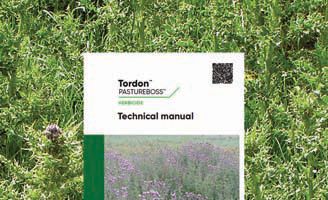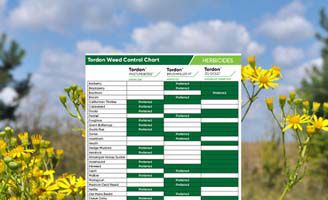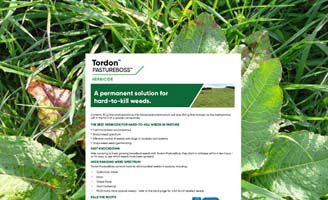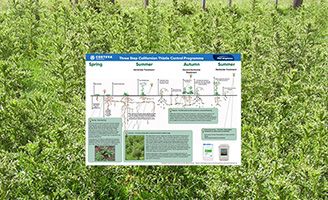Featured Products
Our portfolio of powerful, proven products covers crop protection herbicides to control docks, thistles, gorse as well as other broad-leaved and brush weeds.

Delivering a complete suite of crop protection solutions for today’s farmers.
We combine our world class global research pipeline with our local understanding of pasture production to develop, launch and deliver to market an innovative portfolio of products meeting the needs of the New Zealand farmer.
Our pasture and brushweed portfolio includes product options that provide a solution for most scenarios typically encountered in New Zealand’s landscape.
Our portfolio of powerful, proven products covers crop protection herbicides to control docks, thistles, gorse as well as other broad-leaved and brush weeds.
We've developed a pasture protection portfolio specfically for New Zealand farmers; a portfolio which provides a solution for every situation and ensures they can produce a high-quality crop, maximise on-farm returns, and protect their livelihoods for generations to come.
Effective Californian Thistle control requires a 3-shot spray programme approach.
In the battle against one of New Zealand’s most unwanted pasture weeds, Californian thistle is winning more than it should. One of the reasons is that effective Californian thistle control requires a well-timed, 3-shot programme approach. Key sprays often get missed, or not applied at the correct growth stages, thereby getting poor control.
Ian Kirkland, upper North Island territory sales manager for Corteva Agriscience, says it’s no wonder farmers get disheartened when their efforts to control Californian thistle don’t seem to work.
One herbicide application over 12 months is simply not enough to get control of Californian thistle. It is important to have a 3-shot spray programme with well-timed applications, otherwise this persistent species continues to grow and spread, and the infestation is likely to end up back where it started.
The first herbicide application to Californian thistles should be when they have reached the hardball stage, just before the flowers open. This growth stage is usually around November/December and application timing is important as:
1. Most of the shoots have emerged, so you are less likely to miss spraying any dormant shoots.
2. There is sufficient leaf area on the thistle to absorb herbicide into the plant.
3. Spraying at the hardball stage, prior to flowering means the photosynthates (sugars) are being translocated down into the roots which also aids the translocation of chemical into the root system. Spraying at flowering or after flowering means that a lot of the photosynthates (sugars) stay near the top of the plant for flower and seed development and so the chemical is not translocated to the roots where it is most effective.
The shoot growth of Californian thistles sprayed at hardball stage will die off at the top, however the massive underground root system supporting each plant will respond by sending up fresh new shoots. It is these new shoots that need to be hit hard a second time, several weeks after the first initial herbicide. This is normally around February/March, ideally when the thistles get to knee high and there is plenty of green leaf to absorb the herbicide to allow it to be carried down to the roots. Spraying too early means that not enough of the seedlings have emerged and that the leaf area does not allow enough absorption of the herbicide.
Some of the plants not controlled by the first two herbicide applications may still regrow. While some of these may be controlled by the winter frosts, the remaining plants require a third spot spray application in the following November/December.
Ian Kirkland has seen enough paddocks to notice the impact of farmers skipping the second and third sprays, which he describes as the missing link in effective control programmes.
He puts the proliferation of Californian thistles down to a lack of understanding about the plant in general, as well as a plethora of information (and misinformation), opinion and theory about how to control it. “It’s easy for farmers to get confused, and then discouraged. But it’s also easy for reps to start setting them straight with sound advice and the right herbicide”.
“Tordon Pasture Boss is the best herbicide to control Californian thistles, but it’s still not a one-shot application. They can’t just spray and walk away, wave goodbye from the gate.”
The withholding periods of Tordon PastureBoss are relatively short (three days for milk; seven days for meat). Although Tordon PastureBoss will damage clover, pasture production and grazing are already greatly reduced where Californian thistle populations are high, and that productive ground will be re-gained the following season, and the clover will eventually return.
What’s more important than any herbicide is often a change in mindset.
“Farmers get overloaded with information, the message is diluted, and in some cases they end up not even starting a control programme.
“They need confidence in the fact that they can get things turned around, with the right advice and the right approach. And reps are the people best placed to help them achieve this.”
For more detail contact your Corteva Agriscience territory sales manager.
Download the Cali thistle control guide>
The control of Brushweeds is a regular expense item on most pastoral properties. Although the control of Brushweeds is synonymous with use of herbicides, other farm management practices play an important part in a successful overall programme.
The use of herbicides is only one part of the programme and the failure to carry out complementary farm management practices can result in limited progress.
Methods of Application
The most suitable application method at a particular site will be determined by factors such as topography. Weed size, accessibility, availability of water and spray equipment. Aerial application is the most cost effective method on solid blocks of gorse in hill country or other areas where ground access is difficult.
Aerial spraying, particularly in hill country, is a skilled operation and spray needs to be released close to the target to get the maximum amount of herbicide on the bushes and reduce off-target drift of spray droplets to a minimum.
Brushgun treatment is most suitable for treating scattered infestations, particularly when bushes are up to two metres high.
Motorized Knapsacks are most efficient for treating scattered bushes less than one metre high on steeper hill country where access is more difficult and water is not readily available.
Where only a few isolated bushes occur either cutting the stems at ground level and immediately swabbing the stumps or spraying the base of the stems can be the most cost effective method.
Application Technique
Ground applications should be made from all directions to full cover both foliage and stems. Do not use gun spraying pressures of less than 1000kPa or greater than 2000kPa.
In large dense patches of gorse where full coverage is difficult to achieve it is more practicable to leave the centre unsprayed and treat the following year when the bushes on the perimeter have broken down.
For aerial application it is recommended that the herbicide be applied in 400 litres of water per hectare using the half overlap-opposite pass technique. Best results from aerial treatment are achieved on gorse less than 2 metres high which have stems of less than 3cm diameter.
If gorse is larger than this, consideration should be given to desiccating and burning.
For more information consult your Corteva Territory Manager.
Download the Brushweed Control Manual.
View or Download our Technical Manuals and Quick Reference Sheets here.


A permanent solution to Californian thistle
Download here
A quick guide to the control of common broadleaf weeds and brushweeds in pasture.
Download the chart
For the control of hard-to-kill weeds in pasture.
Download the tech sheet
A granular herbicide regularly used for the control of scattered brushweeds and broadleaf weeds
Download here
Follow our 3 step programme for a permanent solution to Californian thistle
Download herePasture & Brushweed Products
Please clear your filter selections and try again.
Herbicide
For post emergent management of broadleaf weeds in clover, lucerne, chicory, new and mature pasture and maize.
Herbicide
A selective herbicide for the control of annual and perennial broadleaf weeds in pastures.
Herbicide
Controls many difficult-to-kill perennial weeds such as Ragwort, Thistles, Oxeye Daisy and Giant Buttercup, among others.
Herbicide
Controls a range of broadleaf weeds in non-crop areas, tree crops, certain arable crops, pastures, forests and conservation tillage.